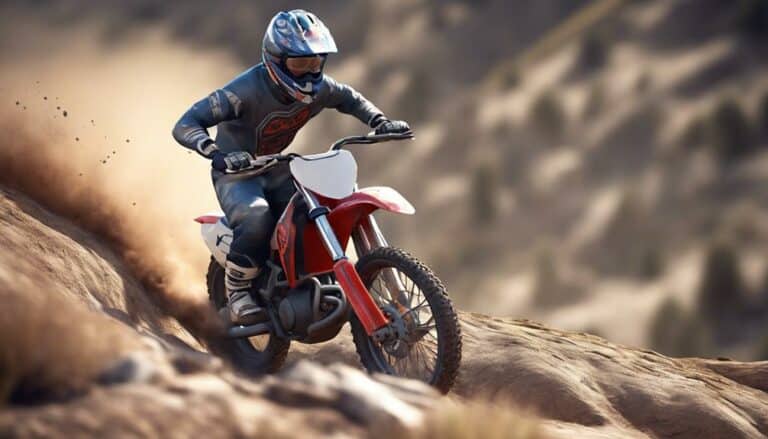Have you ever wondered how your braking techniques on a dirt bike could be refined for better performance? Understanding the nuances of braking on uneven terrain can greatly impact your riding experience.
Mastering the art of braking requires a combination of skill, technique, and finesse. By honing in on key aspects such as body positioning, brake utilization, and control precision, you can take your dirt bike braking to the next level.
Stay tuned to uncover valuable insights on enhancing your braking prowess for a smoother and safer ride.
Key Takeaways
- Maintain low and centered body position for optimal braking control.
- Properly modulate front and rear brakes to maximize braking power.
- Practice braking drills in various terrains for skill enhancement.
- Utilize advanced techniques like engine braking for improved control.
Proper Body Positioning for Braking
When braking on a dirt bike, maintaining a low and centered body position is crucial for optimal control and stability. Your body position directly affects braking efficiency, grip stability, and overall control of the bike.
As you approach a braking maneuver, make sure your weight is evenly distributed over the bike to maximize braking power. Align your hips with the foot pegs, stand on the foot pegs instead of sitting down, and lean back and low over the seat when applying heavy braking pressure.
Utilizing Front and Rear Brakes Effectively
To optimize braking performance on a dirt bike, mastering the effective utilization of both front and rear brakes is vital. The front brake is important as it provides approximately 80% of the braking power, highlighting its significance in achieving efficient stops.
Proper modulation of the front and rear brakes is necessary for maintaining balanced braking control. Start by applying the front brake for initial braking force, then progressively engage the rear brake to enhance stopping power. The rear brake plays a key role in stabilizing the bike, especially on challenging terrains like loose or slippery surfaces.
Coordinating the front and rear brakes seamlessly is essential in improving overall braking efficiency and control. By integrating both brakes harmoniously, you can achieve greater braking power and enhance your ability to navigate various riding conditions effectively.
Importance of Braking Control and Precision
Master the art of precise braking control to conquer challenging terrains on your dirt bike effectively. When it comes to dirt bike riding, the importance of braking control and precision can't be overstated. Here are some key points to take into account:
- Brake Modulation: Adjust your braking power to suit the traction conditions. This skill allows you to maintain control over your bike and prevent skidding on different surfaces.
- Terrain Dynamics: Understand how the terrain affects your braking. Adapt your braking technique based on the terrain you're riding on to maximize control and safety.
- Deceleration: Practice rapid deceleration while maintaining control. Being able to slow down quickly without losing stability is essential for handling challenging sections of the trail.
- Overall Riding Safety: Improving your braking precision enhances your safety on the trail. By mastering precise braking control, you increase your confidence and reduce the risk of accidents. Remember, control is key for a safe and thrilling dirt bike riding experience.
Implementing Braking Drills for Skill Enhancement
Incorporate braking drills strategically to enhance your dirt bike riding skills efficiently. Begin with emergency braking drills to hone your ability to stop quickly and maintain control in high-pressure situations. Focus on distributing your weight properly during these drills to improve stability and handling.
Utilize exercises that emphasize both the front and rear brake to develop muscle memory and reflexes for better braking response. It's important to practice braking in various terrain conditions to adapt your technique and refine your skills based on the surface you're riding on.
Implement cornering drills that incorporate braking to enhance your overall handling and control while managing turns. By consistently practicing these drills, you'll become more adept at handling your bike in different situations, ultimately improving your confidence and performance on the track or trail.
Advancing Braking Techniques for Dirt Biking
Enhance your dirt biking braking proficiency by exploring advanced techniques to elevate your control and precision on the trails.
- Master the Attack Position: Maintain a balanced stance with your elbows up, standing on the footpegs, and gripping the bike with your knees to improve stability while braking aggressively.
- Engage the Front Brake Lever: Gradually apply the front brake lever to transfer weight to the front wheel for increased traction and shorter stopping distances.
- Utilize Engine Braking: Downshift before braking to harness the engine's resistance for smoother deceleration without locking up the wheels.
- Combine Rear Brakes with Front: Enhance braking efficiency by using the rear brake for stability and the front brake for stopping power, allowing you to control speed effectively on varied terrain.
Conclusion
You've learned how to improve your dirt bike braking techniques through mastering body positioning, utilizing both brakes effectively, and focusing on control and precision.
Did you know that proper braking can reduce your stopping distance by up to 25%? Keep practicing and honing your skills to guarantee a safer and more enjoyable riding experience.
Remember, mastering braking techniques is essential for your performance and safety on the trails.

